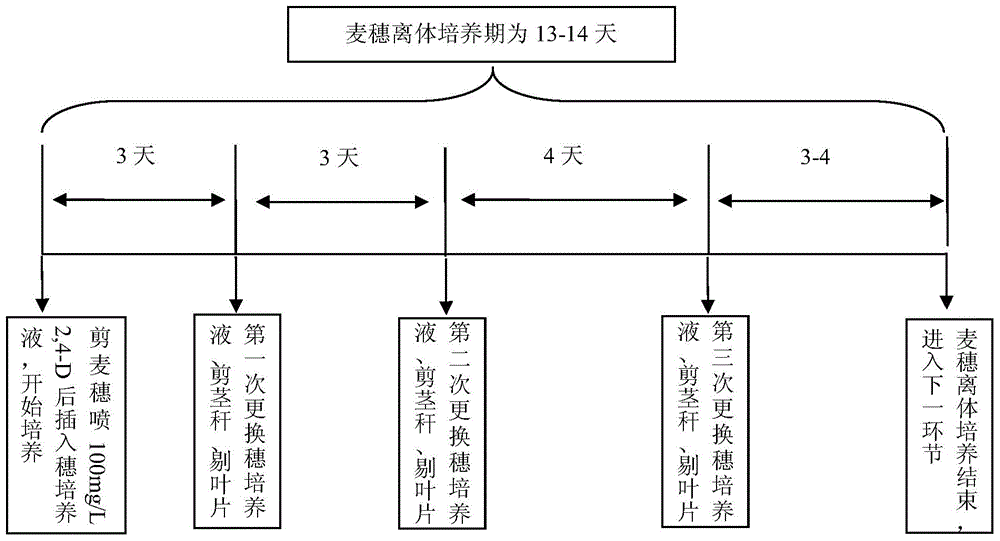Wheat ear in-vitro culture method through wheat and corn hybridization and haploidembryo induction
An in vitro culture and haploid technology, applied in the agricultural field, can solve the problems of leaf photosynthesis, damaged or suspended respiration, space occupation, and unstable induction rate of wheat haploid embryos
- Summary
- Abstract
- Description
- Claims
- Application Information
AI Technical Summary
Problems solved by technology
Method used
Image
Examples
Embodiment 1
[0018] Preparation of ear culture solution: See "Journal of Wheat Crops", No. 1, 2008, pages 1-5 for the formula of the culture solution. Weigh 100mg of 2,4-dichlorophenoxyacetic acid (alias: 2,4-D, analytically pure) into a beaker, add 50-60ml of sodium hydroxide with a concentration of 0.1N (prepared with analytically pure sodium hydroxide ), stir with a glass rod or a stirrer to completely dissolve 2,4-dichlorophenoxyacetic acid; use a container with a capacity of 1000ml to measure 600ml of tap water, and add 40g of sucrose (food grade) and potassium dihydrogen phosphate (chemically pure ) 3g, sulfurous acid (analytical pure) 8ml, silver nitrate (analytical pure) 10mg and dissolved 2,4-dichlorophenoxyacetic acid; add tap water to 1000ml, shake well, pour into a dark container at room temperature and store for later use .
[0019]On August 5, 2008, at the Kunming Experimental Base of the Yunnan Academy of Agricultural Sciences, at 11:00 in the morning, 92 wheat ears of 15 w...
Embodiment 2
[0021] Professor Yu Dazhao from the Institute of Plant Protection, Soil and Fertilizer, Hubei Academy of Agricultural Sciences provided 2 wheat hybrid combinations F 0 The first generation seeds were sown in Kunming Experimental Base of Yunnan Academy of Agricultural Sciences in June 2009. The purpose is to use the wheat x corn hybrid haploid induction technology to construct two doubled haploid populations for the inheritance and gene mapping of wheat powdery mildew resistance genes For research, at least 300 doubled haploid plants were obtained from each group.
[0022] On August 11, 2009, the first batch of emascated 154 ears of wheat were pollinated, and the formula of the ear culture solution and its preparation method, and the indoor in vitro culture method were exactly the same as those in Example 1. The cultivation ended on August 26, 154 wheat ears had 4781 florets, 4613 caryopsis were obtained, and 1587 haploid embryos were peeled off under a dissecting microscope, w...
PUM
 Login to View More
Login to View More Abstract
Description
Claims
Application Information
 Login to View More
Login to View More - R&D
- Intellectual Property
- Life Sciences
- Materials
- Tech Scout
- Unparalleled Data Quality
- Higher Quality Content
- 60% Fewer Hallucinations
Browse by: Latest US Patents, China's latest patents, Technical Efficacy Thesaurus, Application Domain, Technology Topic, Popular Technical Reports.
© 2025 PatSnap. All rights reserved.Legal|Privacy policy|Modern Slavery Act Transparency Statement|Sitemap|About US| Contact US: help@patsnap.com

